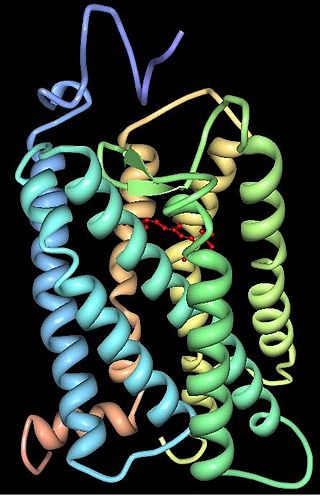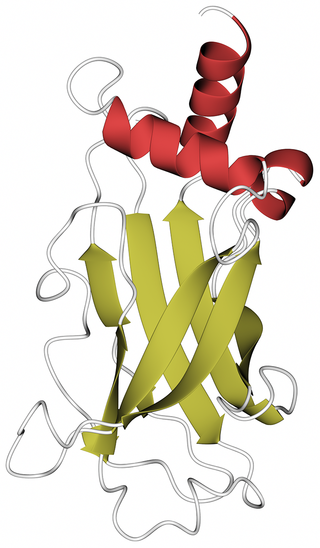Related Research Articles

Rhodopsin, also known as visual purple, is a protein encoded by the RHO gene and a G-protein-coupled receptor (GPCR). It is the opsin of the rod cells in the retina and a light-sensitive receptor protein that triggers visual phototransduction in rods. Rhodopsin mediates dim light vision and thus is extremely sensitive to light. When rhodopsin is exposed to light, it immediately photobleaches. In humans, it is regenerated fully in about 30 minutes, after which the rods are more sensitive. Defects in the rhodopsin gene cause eye diseases such as retinitis pigmentosa and congenital stationary night blindness.

Retinitis pigmentosa (RP) is a genetic disorder of the eyes that causes loss of vision. Symptoms include trouble seeing at night and decreasing peripheral vision. As peripheral vision worsens, people may experience "tunnel vision". Complete blindness is uncommon. Onset of symptoms is generally gradual and often begins in childhood.
The Human Genome Diversity Project (HGDP) was started by Stanford University's Morrison Institute in 1990s along with collaboration of scientists around the world. It is the result of many years of work by Luigi Cavalli-Sforza, one of the most cited scientists in the world, who has published extensively in the use of genetics to understand human migration and evolution. The HGDP data sets have often been cited in papers on such topics as population genetics, anthropology, and heritable disease research.

Sir Walter Fred Bodmer is a German-born British human geneticist.

The Wellcome Sanger Institute, previously known as The Sanger Centre and Wellcome Trust Sanger Institute, is a non-profit British genomics and genetics research institute, primarily funded by the Wellcome Trust.

The Burusho, or Brusho, also known as the Hunzukuch, are an ethnolinguistic group indigenous to the Yasin, Hunza, Nagar, and other valleys of Gilgit–Baltistan in northern Pakistan, with a tiny minority of around 350 Burusho people residing in Jammu and Kashmir, India. Their language, Burushaski, has been classified as a language isolate.

David Haussler is an American bioinformatician known for his work leading the team that assembled the first human genome sequence in the race to complete the Human Genome Project and subsequently for comparative genome analysis that deepens understanding the molecular function and evolution of the genome.

RPE-retinal G protein-coupled receptor also known as RGR-opsin is a protein that in humans is encoded by the RGR gene. RGR-opsin is a member of the rhodopsin-like receptor subfamily of GPCR. Like other opsins which bind retinaldehyde, it contains a conserved lysine residue in the seventh transmembrane domain. RGR-opsin comes in different isoforms produced by alternative splicing.

X-linked retinitis pigmentosa GTPase regulator is a GTPase-binding protein that in humans is encoded by the RPGR gene. The gene is located on the X-chromosome and is commonly associated with X-linked retinitis pigmentosa (XLRP). In photoreceptor cells, RPGR is localized in the connecting cilium which connects the protein-synthesizing inner segment to the photosensitive outer segment and is involved in the modulation of cargo trafficked between the two segments.

X-linked retinitis pigmentosa GTPase regulator-interacting protein 1 is a protein in the ciliary transition zone that in humans is encoded by the RPGRIP1 gene. RPGRIP1 is a multi-domain protein containing a coiled-coil domain at the N-terminus, two C2 domains and a C-terminal RPGR-interacting domain (RID). Defects in the gene result in the Leber congenital amaurosis (LCA) syndrome and in the eye disease glaucoma.

Rod outer segment membrane protein 1 is a protein that in humans is encoded by the ROM1 gene.
Sir Michael Rudolf Stratton, is a British clinical scientist and the third director of the Wellcome Trust Sanger Institute. He currently heads the Cancer Genome Project and is a leader of the International Cancer Genome Consortium.

The Friedrich Miescher Institute for Biomedical Research (FMI) is a biomedical research institute founded in 1970. Based in Basel, Switzerland, the FMI is affiliated with the University of Basel and the Novartis Institutes for BioMedical Research (NIBR). It is named after Friedrich Miescher. As of 2021, the FMI has around 340 collaborators, of which 20 are research group leaders, over 80 are postdoctoral collaborators and over 80 are postgraduate students participating in the FMI International PhD Program. The FMI is directed by Dirk Schübeler.

The Wellcome Centre for Human Genetics is a human genetics research centre of the Nuffield Department of Medicine in the Medical Sciences Division, University of Oxford, funded by the Wellcome Trust among others.
Haplogroup Q-M120, also known as Q1a1a1, is a Y-DNA haplogroup. It is the only primary branch of haplogroup Q1a1a (F746/NWT01). The lineage is most common amongst modern populations in north-east Eurasia.

Julie Angela Segre is the Chief and Senior Investigator of the Translational and Functional Genomics Branch in the National Human Genome Research Institute at the National Institutes of Health. She was elected to the National Academy of Medicine in 2019, the American Academy of Arts and Sciences in 2020 and the National Academy of Sciences in 2022.

alpha/beta-Hydrolase domain containing 12 (ABHD12) is a serine hydrolase encoded by the ABHD12 gene that participates in the breakdown of the endocannabinoid neurotransmitter 2-arachidonylglycerol (2-AG) in the central nervous system. It is responsible for about 9% of brain 2-AG hydrolysis. Together, ABHD12 along with two other enzymes, monoacylglycerol lipase (MAGL) and ABHD6, control 99% of 2-AG hydrolysis in the brain. ABHD12 also serves as a lysophospholipase and metabolizes lysophosphatidylserine (LPS).

Robert E. MacLaren FMedSci FRCOphth FRCS FACS VR is a British ophthalmologist who has led pioneering work in the treatment of blindness caused by diseases of the retina. He is Professor of Ophthalmology at the University of Oxford and Honorary Professor of Ophthalmology at the UCL Institute of Ophthalmology. He is a Consultant Ophthalmologist at the Oxford Eye Hospital. He is also an Honorary Consultant Vitreo-retinal Surgeon at the Moorfields Eye Hospital. MacLaren is an NIHR Senior Investigator, or lead researcher, for the speciality of Ophthalmology. In addition, he is a member of the research committee of Euretina: the European Society of Retina specialists, Fellow of Merton College, in Oxford and a Fellow of the Higher Education Academy.
The study of the genetics and archaeogenetics of the Gujarati people of India aims at uncovering these people's genetic history. According to the 1000 Genomes Project, "Gujarati" is a general term used to describe people who trace their ancestry to the region of Gujarat, located in the northwestern part of the Indian subcontinent, and who speak the Gujarati language, an Indo-European language. They have some genetic commonalities as well as differences with other ethnic groups of India.

The African Society of Human Genetics (AfSHG) is a learned society and professional membership organization focused on the study of human genetics and genomics in Africans, and open to researchers who are interested in the subject. It has played a role in founding several national genetics societies, and is affiliated with the societies of Cameroon, the Democratic Republic of the Congo, Mali, Egypt, Rwanda, Senegal, South Africa, and Tanzania.
References
- ↑ "Dr Qasim Mehdi dies in Lahore". 2016-09-30.
- 1 2 3 "Prof. S. Qasim Mehdi". hstalks.com. Retrieved 7 June 2016.
- 1 2 "Prof. Syed Qasem Mehdi". ias-worldwide.org. Retrieved 7 June 2016.
- ↑ Xue, Yali; Zhang, Xuelong; Huang, Ni; Daly, Allan; Gillson, Christopher J.; MacArthur, Daniel G.; Yngvadottir, Bryndis; Nica, Alexandra C.; Woodwark, Cara; Chen, Yuan; Conrad, Donald F.; Ayub, Qasim; Mehdi, S. Qasim; Li, Pu; Tyler-Smith, Chris (1 November 2009). "Population Differentiation as an Indicator of Recent Positive Selection in Humans: An Empirical Evaluation". Genetics. 183 (3): 1065–1077. doi:10.1534/genetics.109.107722. PMC 2778960 . PMID 19737746 . Retrieved 7 June 2016.
- ↑ "Syed Qasim Mehdi - Info". researchgate.net. Retrieved 7 June 2016.
- ↑ "THE FUTURE OF MEDICINE AND BIOMEDICAL RESEARCH IN PAKISTAN: 1st Draft" (PDF). pc.gov.pk. Archived from the original (PDF) on 31 May 2016. Retrieved 7 June 2016.
- ↑ "Syed Qasim Mehdi - Google Scholar Citations". google.com. Retrieved 7 June 2016.
- ↑ "Distinguished scientist: Dr Qasim Mehdi passes away". 2016-09-29.